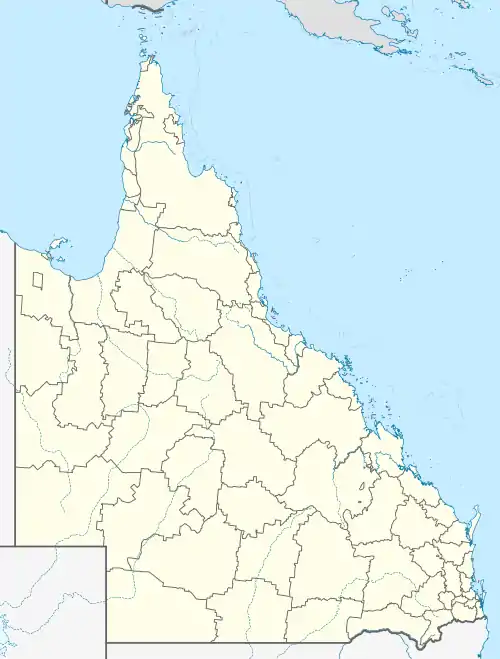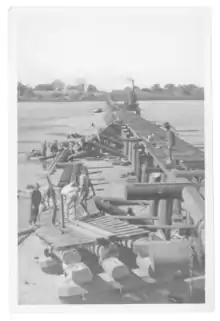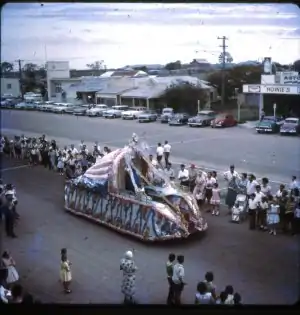Home Hill, Queensland
Home Hill is a town and locality in the Burdekin Shire, Queensland, Australia at the delta of the Burdekin River.[2][3] It is a sugarcane growing area with underground water supplies to irrigate crops.
| Home Hill Queensland | |||||||||||||||
|---|---|---|---|---|---|---|---|---|---|---|---|---|---|---|---|
 View of Home Hill's main street, along the Bruce Highway | |||||||||||||||
 Home Hill | |||||||||||||||
| Coordinates | 19°39′40″S 147°24′50″E | ||||||||||||||
| Population | 3,027 (2011 census)[1] | ||||||||||||||
| Established | 1912 | ||||||||||||||
| Postcode(s) | 4806 | ||||||||||||||
| Location |
| ||||||||||||||
| LGA(s) | Shire of Burdekin | ||||||||||||||
| State electorate(s) | Burdekin | ||||||||||||||
| Federal Division(s) | Dawson | ||||||||||||||
| |||||||||||||||
Geography
-01(1).jpg.webp)
Home Hill lies approximately 98 kilometres (61 mi) south of Townsville and 1,269 kilometres (789 mi) north of the state capital Brisbane on the Bruce Highway. It is a part of the Burdekin Region which includes the neighbouring town of Ayr. Both towns are governed by the Burdekin Shire Council.
The Burdekin River forms the locality's north-western boundary. The urban area is situated centrally within the locality surrounded by crop farming. The Bruce Highway passes through the town from the south-east to the north-west crossing the river via the Burdekin Bridge to Ayr. The North Coast railway line runs immediately parallel and south of the highway with the Home Hill railway station located in the town centre; it too crosses the river on the Burdekin Bridge. To the west of the town is Gardiner's Lagoon. Despite its name, the land in the locality is very flat.[4]
Economy
The town relies on its primary industries. The major crop is sugarcane. Other crops include mango and various vegetables.
History

Yuru (also known as Juru, Euronbba, Juru, Mal Mal, Malmal) is an Australian Aboriginal language spoken on Yuru country. The Yuru language region includes the landscape within the local government boundaries of the Shire of Burdekin, including the town of Home Hill.[5]
Home Hill was originally part of the Inkerman Downs Cattle Station. In August 1910, the Inkerman estate was resumed by the Queensland Government under the Closer Settlement Act.[6][7] It was subdivided into farming allotments. Although the town of Ayr was very close by, there was no bridge across the Burdekin River and hence it was necessary to establish a separate town to support the new farming community.[8] The first blocks of town land were offered for sale in December 1912 under the name of Home Hill.[9]
The origin of the name Home Hill is much disputed.[10] The Queensland Government claims it was named after Home Hill, a hilltop defended by the British Army in the Battle of Inkerman in the Crimean War.[2] However it has also been claimed that it was named after Colonel Home who lived in the district and had fought in the Crimea.[11] Another claim is that the name was originally Holme Hill which was corrupted into Home Hill, possibly by a signwriter painting the name at the railway station.[8][12][13] A newspaper report in September 1912 calls the proposed town Holme Hill but also makes the connection with the Battle of Inkerman.[12] There are also numerous early references to the town as Holm Hill.[14] Certainly the Hill part of the name does not relate to the local geography which is quite flat with the nearest hill is about 10 kilometres (6.2 mi) away.[4]
Home Hill Post Office opened by 1913 (a receiving office had been open from 1912).[15] In the 1990s there were rumours that the post office would be closed. However, eventually the decision was made to privatise it in 1997.[16]
A tent school was opened in the district on 23 March 1913 but was replaced by the Inkerman State School on 25 October 1913 which was renamed Home Hill State School on 19 January 1914.[17][18] Another Inkerman State School was opened in 1915 and was closed on 31 December 1974.[19]
The Inkerman Bridge across the Burdekin River to McDesme officially opened on 8 September 1913.[20] The bridge carried the North Coast railway line. As the nearest road bridge across the river was 37 miles (60 km) upstream, a low-level road bridge was built across the river (19.6283°S 147.4044°E) in 1929 and was completed in January 1930 and within two weeks was 3 feet (0.91 m) under water due to the river flooding.[21][22][23][24] Due to the frequent flooding of the river, the rail and road bridges were often closed or damaged, leading to the decision to build a single higher-level road-and-rail bridge.[8][25] Due to the lack of rock in the sandy soil to use as foundations, for many years it was not believed possible to build a high-level bridge across the Burdekin River. However, by copying construction techniques used in India for sand-footing bridges, work began on the Burdekin Bridge (also known as the Silver Link) in April 1947 but it was not operational until 27 March 1957. The new bridge was 100 metres (330 ft) upstream of the Inkerman Bridge.[26] The Burdekin Bridge officially opened on 15 June 1957.[27][28] At 1,097 metres (3,599 ft), the Burdekin Bridge is one of the longest multi-span bridges in Australia and the only one in Australia without a firm footing.[29] Some pylons of the Inkerman Bridge are still visible.[30]
The farming allocations were taken up to grow sugar cane and the town developed quite quickly after the establishment of the Inkerman sugar mill in 1914.
The earliest recorded burials in Home Hill cemetery were in 1917.[31] In 2007 a lawn cemetery section was added.[16]
In 1922, a power station was built enabling electricity to be supplied for the first time in Home Hill.[16]
In 1923, the first courthouse in Home Hill opened, operating from a timber building that had formerly been used as Jensen's Boot Palace. The building was relocated to the present courthouse site, where it was replaced by the extant brick structure in 1937. The court house closed in 1991 after which it was occupied by a tourist information centre and then local radio station Sweet FM.[32]
Home Hill's own newspaper the ''Home Hill Observer'' commenced in 1923 under proprietor and editor Thomas (Tom) Jackson, relocating offices a number of times over the years. In June 2014, the newspaper ceased publication; the then editor was David Jackson, grandson of Tom.[16][33]
The Home Hill Agricultural, Horticultural and Industrial Society held its first show on 20 November 1926. In 1935 the society established its own grounds and erected pavilions. The shows were held annually (apart from 1942 to 1944 due to World War II) until 2001 when the shows were no longer economically viable.[16]
On 16 February 1959, Cyclone Connie struck Home Hill. No building escaped damage with every window broken in the main street. One hundred people were made homeless.[34]
The first Home Hill Harvest Festival was held in 1963.[16] It continues to be held annually in November to celebrate the end of the sugar cane crushing season.[35]
Home Hill State High School opened on 28 January 1964.[17]
Some farmers began to experiment with rice in the 1960s with a local rice mill opening in 1968. However, the rice industry collapsed in Queensland in 1994 when the Queensland Rice Marketing Board experienced financial difficulties bringing this crop to an end in the Home Hill area. However, other crops have been introduced to the area and found their niche in the economy; they include mangoes, cucumbers, tomatoes, chillies, sorghum, maize, cotton and cassava.[16]
Town water via a water tower was supplied in Home Hill from 27 March 1968. Prior to this many used windmills and electric pumps to extract water from beneath the ground. Sewerage was installed from 1976 to 1979 with most household using septic tanks before then.[16]
In the mid 1980s, the economics of sugarcane farming worsened with rising costs and falling prices. Mechanisation was needed to reduce labour costs but the cost of purchasing the equipment was high. Small farms became increasingly less viable leading to the slogan "Get big or get out" which saw many leave the industry allowing those who remained to create larger more viable farms.[16]
At the 2006 census, Home Hill had a population of 2,907.[36]
In the 2011 census, Home Hill had a population of 3,027 people.[1]
In August 2016, two British backpackers were killed in a stabbing attack at the Home Hill Backpackers hostel, leaving others injured, by a French national shouted "Allahu Akbar" during the killings and during his arrest[37] and who had allegedly used cannabis on the night of the attack.[38][39]
Heritage listings
Home Hill has a number of heritage-listed sites, including:
- First Avenue: Home Hill Powerhouse[40]
Amenities
The Burdekin Shire Council operates a Public Library service at 77-79 Ninth Ave.[41] It opened in 1984 and in 2017 underwent a major refurbishment.[42][43]
St Stephen's Greek Orthodox Church is at 1-5 Eighth Avenue (19.6702°S 147.4179°E).[44]
Tourism
The main attractions in Home Hill are the Burdekin Bridge, Inkerman Sugar Mill and Ashworth's Rock Shop. In the past few years it has become increasingly popular for backpackers, who flock to the area to earn money planting and harvesting crops.
Events

The Home Hill Harvest Festival is an annual week-long program of events held in November, culminating in a street parade and Mardi Gras.[35]
The Burdekin Race Club holds regular race days at Home Hill.[45]
Notable residents
- Anne Geddes, photographer
- Gordon Hookey, artist
- Rosemary Menkens, politician
- Donald Nicklin, chemical engineer and professor, born in Home Hill [46]
- Craig Wallace, politician
See also
References
- Australian Bureau of Statistics (31 October 2012). "Home Hill". 2011 Census QuickStats. Retrieved 7 September 2015.

- "Home Hill (entry 16048)". Queensland Place Names. Queensland Government. Retrieved 13 March 2014.
- "Home Hill (entry 42288)". Queensland Place Names. Queensland Government. Retrieved 7 September 2015.
- "Queensland Globe". State of Queensland. Retrieved 18 March 2019.
-
 This Wikipedia article incorporates CC-BY-4.0 licensed text from: "Yuru". Queensland Aboriginal and Torres Strait Islander languages map. State Library of Queensland. Retrieved 23 January 2020.
This Wikipedia article incorporates CC-BY-4.0 licensed text from: "Yuru". Queensland Aboriginal and Torres Strait Islander languages map. State Library of Queensland. Retrieved 23 January 2020.
- "'6. Closer settlement in Queensland' in Struggle Country: The Rural Ideal in Twentieth Century Australia by Graeme Davison and Marc Brodie | EPress". books.publishing.monash.edu. Archived from the original on 4 March 2016. Retrieved 7 September 2015.
- "Northern Estate Repurchase of Inkerman. Crown to Pay £130,266". Queensland Times. 26 August 1910. p. 8. Archived from the original on 25 December 2020. Retrieved 7 September 2015.
- "Home Hill". Queensland Places. Centre for the Government of Queensland, University of Queensland. Archived from the original on 14 March 2020. Retrieved 18 July 2020.
- "Advertising". Bowen Independent. 3 December 1912. p. 3. Archived from the original on 25 December 2020. Retrieved 7 September 2015.
- Scott, Laura A; Lower Burdekin Historical Society (2011), John Drysdale's dream : Home Hill : the first fifty years, Lower Burdekin Historical Society Inc, ISBN 978-0-9871987-0-9
- "NOMENCLATURE OF QUEENSLAND.—151". The Courier-Mail. 24 March 1936. p. 12. Archived from the original on 25 December 2020. Retrieved 7 September 2015.
- "LOWER BURDEKIN NOTES AYR, Sept 24". Townsville Daily Bulletin. 27 September 1912. p. 3. Archived from the original on 25 December 2020. Retrieved 7 September 2015.
- "And More Again... | The Little House of Concrete Non-Fiction". littlehouseofconcrete.net. Archived from the original on 4 March 2016. Retrieved 7 September 2015.
- "Townsville Land Court". Townsville Daily Bulletin. 8 January 1913. p. 6. Archived from the original on 25 December 2020. Retrieved 7 September 2015.
- Premier Postal History. "Post Office List". Premier Postal Auctions. Archived from the original on 15 May 2014. Retrieved 10 May 2014.
- Scott, Laura A; Lower Burdekin Historical Society (2014), Mastering the dream : Home Hill : jubilee to centenary, Home Hill, Q The Lower Burdekin Historical Society Inc, ISBN 978-0-9871987-1-6
- "Opening and closing dates of Queensland Schools". Queensland Government. Retrieved 2 February 2021.
- "Agency ID 5316, Home Hill". Queensland State Archives. Retrieved 7 September 2015.
- "Agency ID 969, Inkerman State School". Queensland State Archives. Retrieved 7 September 2015.
- "NORTH COAST RAILWAY LINE". Townsville Daily Bulletin. XXX (9623). Queensland, Australia. 10 September 1913. p. 6. Archived from the original on 13 January 2021. Retrieved 14 January 2021 – via National Library of Australia.
- "A TRAFFIC BRIDGE". The Northern Herald. L (651). Queensland, Australia. 23 September 1925. p. 35. Retrieved 14 January 2021 – via National Library of Australia.
- "TRAFFIC BRIDGE OVER BURDEKIN RIVER". Bowen Independent. 24 (2019). Queensland, Australia. 6 November 1928. p. 3. Retrieved 14 January 2021 – via National Library of Australia.
- "ROADS COMMISSION". Toowoomba Chronicle And Darling Downs Gazette. LXIX (13). Queensland, Australia. 15 January 1930. p. 4. Retrieved 14 January 2021 – via National Library of Australia.
- "THE CROSSING OF THE BURDEKIN RIVER". The Queenslander. Queensland, Australia. 16 January 1930. p. 29. Retrieved 14 January 2021 – via National Library of Australia.
- "Chronological History of Flooding 1857-2010" (PDF). Harden Up. Archived (PDF) from the original on 30 May 2015. Retrieved 14 January 2021.
- "NEW QUEENSLAND BRIDGE". Western Herald. New South Wales, Australia. 19 April 1957. p. 4. Archived from the original on 13 January 2021. Retrieved 14 January 2021 – via National Library of Australia.
- "Burdekin Bridge". Monument Australia. Retrieved 13 January 2021.
- Denyer, Winsome (20 November 2008). "Memories from the Burdekin Bridge". Australian Broadcasting Corporation. Retrieved 13 January 2021.
- Wensley, Penelope (5 October 2010). "Engineering Heritage National Landmark Award to the Burdekin River Bridge". Government House, Queensland. Archived from the original on 27 February 2014. Retrieved 7 September 2015.
- Google (14 January 2021). "Inkerman Bridge (remnants)" (Map). Google Maps. Google. Retrieved 14 January 2021.
- "Burial Register - Burdekin Shire Council". Archived from the original on 10 September 2015. Retrieved 8 September 2015.
- "Heritage Town Walk: Home Hill". Burdekin Shire Council. Archived from the original on 25 March 2016. Retrieved 8 September 2015.
- "Goodbye to the Home Hill Observer". ABC North Queensland. Archived from the original on 4 March 2016. Retrieved 8 September 2015.
- "Cyclone Connie – Harden Up - Protecting Queensland". hardenup.org. Archived from the original on 8 September 2015. Retrieved 8 September 2015.
- "Home Hill Harvest Festival - Oct and Nov - Burdekin Shire Council". Archived from the original on 10 September 2015. Retrieved 8 September 2015.
- Australian Bureau of Statistics (25 October 2007). "Home Hill (Urban Centre/Locality)". 2006 Census QuickStats. Retrieved 24 May 2011.
- "Home Hill hostel stabbing: 'Hero' British backpacker dies in hospital". 9 News Australia. Archived from the original on 2 October 2016. Retrieved 28 September 2016.
Police allege Mr Ayad yelled "Allahu Akbar" - an Islamic phrase meaning "God is great" - during the attack and again during his arrest.
- Robertson, Joshua; Grierson, Jamie (24 August 2016). "Queensland stabbing: British woman killed by attacker who allegedly shouted 'Allahu Akbar'". The Guardian. ISSN 0261-3077. Archived from the original on 24 August 2016. Retrieved 25 August 2016.
- "Archived copy". Archived from the original on 15 September 2016. Retrieved 9 September 2016.CS1 maint: archived copy as title (link)
- "Home Hill Powerhouse (entry 601718)". Queensland Heritage Register. Queensland Heritage Council. Retrieved 7 July 2013.
- "Home Hill Library". Public Libraries Connect. 28 July 2015. Archived from the original on 19 January 2018. Retrieved 19 January 2018.
- "Queensland Public Library Statistical Bulletin 2016-17" (PDF). Public Libraries Connect. November 2017. Archived (PDF) from the original on 30 January 2018. Retrieved 19 January 2018.
- "Library Burdekin Shire Council". Burdekin Shire Council. Archived from the original on 19 January 2018. Retrieved 19 January 2018.
- "St Stephen, Home Hill, QLD". Greek Orthodox Archdiocese of Australia. Archived from the original on 25 December 2020. Retrieved 25 December 2020.
- "Burdekin RC". www.burdekinraceclub.com.au. Archived from the original on 18 November 2015. Retrieved 8 September 2015.
- "Innovative engineer". The Courier Mail. November 3, 2007. 3 November 2007.
Further reading
- Home Hill State Primary School (1988), 75 years 1913-1988 : Home Hill State Primary School, Home Hill State Primary School. 75th Anniversary Committee, ISBN 978-0-7316-5233-4
External links
| Wikimedia Commons has media related to Home Hill, Queensland. |